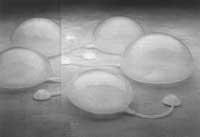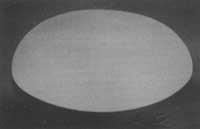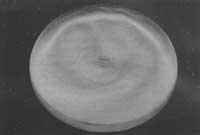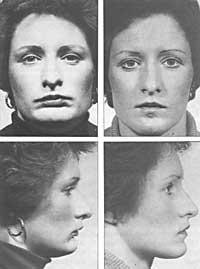Silicone breast prosthesis
1992/05/01 Furundarena Salsamendi, Jose Ramon | Cormenzana Olaso, P.S. Iturria: Elhuyar aldizkaria
Introduction Introduction Introduction Introduction
Silicone prostheses are alloplastic biomaterials essential in breast plastic surgery. These materials are used both in the form of frighteners and implants. The difference between these two uses is that, in the case of the implant, the implantation of the prosthesis is definitive (both in the reconstructive surgery and in the enlargement mamoplasty), while the frighteners are used for the reconstruction of the breast and for the creation of a surplus of tissue for the congenital correction, in order to the second phase the definitive prosthesis can be placed. Of course, all alloplastic implants must be biocompatible to avoid toxic, immune, or carcinogenic reactions.
Structure of breast prostheses
The conventional breast prosthesis is of silicone outer coating with silicone inner room. The scavenger has the same outer surface, but the desired expansion volume is obtained by introducing saline serum through a surface valve.

In 1982 and 1984, the final shocks were developed to prevent the reconstruction of the breasts. These are called Becker espanteros and are formed by two compartments, one with silicone room and the other with valve that the salt serum is introduced to obtain the desired volume of tissue. Once obtained, they are definitively implanted.
Chemical composition and silicone types
Silicones were marketed in 1943. For its usefulness in many medical applications, numerous types of silicone have been developed (especially in the last 20 years) and plastic surgery itself has been one of the areas in which silicone polymers have been most applied.
Silicones are organic compounds that contain silicon. The silicone polymers used in plastic surgery are therefore long chains formed by repetitions of a unit. Take for example dimethylsiloxane as a unit (monomer). The polymerization allows obtaining chains of different sizes. If these silicone polymers are formed in a few units, we will have silicones of low molecular weight and will be fluid. As the molecular weight increases, that is, as the chain stretches, the silicone will be more viscous. Polymer chains can be combined with three-dimensional structures. These are silicone classrooms (50-500 units) and elastomers (500-2,000 units).
Silicone gel prosthesis are formed by different types of silicone. Tests have been conducted in laboratory animals to analyze the response of the tissues of implantation of these prostheses. The lowest cellular and capsule response intensity has been obtained with silicone oil and has been observed to increase with molecular weight. From these studies it is concluded that the molecular weight of the polymer influences the migration, cover and intensity of the cellular response.
Silicone complications silicone complications
Immunological reactions: immunological reactions
There is much literature that says that silicone is an inert substance. But it is increasingly clear that silicone is neither inert nor chemically nor biologically. Its complications are increasingly mentioned, especially the immunological ones and the encapsulated contraction. Small particles between 10 and 60 microns have been found to be capable of producing immunological interactions. However, no scientific reference has been found to link silicone with the origin of cancer.
Several researchers have studied the possible leakage of gel or diffusion of silicone from the elastomer membrane of the prosthesis. Rudolph and collaborators have found the drops of the silicone room that have passed through the silicone membrane in the same tissue surrounding the implantation or in other distant ones, clearly explaining that they have migrated. Silicone particles phagocyted in macrophages and textile lymphocytes and in mumocytes and polymorphonuclear leukocytes of peripheral blood have been found. Silicone has been found in most viscera of the body.
The antigenic capacity of silica is demonstrated. Silicone can become silica (silicon dioxide) after the phagocyte of macrophages. Silica can produce autoantibodies and diseases of connective tissues such as systemic lupus erythematosus and scleroderma.
It has been proposed that silicone microparticles can also act as haptenos or incomplete antigens to form antigenic complexes combined with other molecules.
Some Japanese researchers have explained that in some cases, after the injection of silicone, some patients suffer years after arthritis, arthritis, artralgia, lymphadenopathy and the proliferation of gammaglobulins and the positivization of the rheumatoid factor. Especially women who have received silicone injections in breasts or other places, these researchers have described that two years later they have shown symptoms similar to autoimmune diseases. This situation was called “promoting human disease”. The patients had autoantibodies and other serological changes and the symptoms improved by eliminating the foreign substance. Others developed some disease such as lupus erythematosus, Sjögren syndrome, and Hashimoto thyroiditis.
It should not be forgotten, however, that at present in breast augmentation mammoplasties no fluid silicone is used and that most of the cases of immunological changes described have been produced more than ten years ago using this type of silicone. As the manufacture of silicone prostheses has been evolving, the diffusion of silicone microparticles has been complicated. The trilaminic prosthesis of rough surface that were launched on the market in 1987, are a great advance on this road.
The first autoimmune syndrome produced by augmented mammoplasty with silicone gel prosthesis was described in 1982 by Van Nunen and in 1983 by Baldwin and Kaplan. They then published their first American case. After the withdrawal of the implant, the symptoms disappeared.
Capular contraction


After the implantation of the prosthesis in the body a textile capsule is developed surrounding it. Contraction of this layer surrounding the prosthesis can cause spherical obstruction of the implant, distorting the structure of the chest and overturning the initial surgical result. The frequency of this complication varies between 0% and 74% depending on the different sources. The cause would be the diffusion of silicone gel microparticles from the prosthesis coating.
To deal with capsule contraction, the characteristics of breast prostheses have been changing. Trilaminated breast implants were designed to protect the body from these microparticles. For a wrinkled or irregular surface, the external silicone elastomer was modified. It has a triple coating of “low flow” material. The first clinical reports indicate that the incidence of capular contraction is very low, both when the prosthesis is placed in the gland and when it is subjected to muscle and fascia. Therefore, this type of prosthesis has been an advance. Not only in the prevention of encapsulated contraction, but also in the prevention of reactions derived from the diffusion of silicone microparticles.
Conclusion of the conclusion Conclusion
Cases of adverse immune effects have been anecdotal, but cannot be forgotten. These problems should be addressed scientifically, as it seems reasonable that silicone implants can cause autoimmune problems in some receptors.
Probably in the future patients with connective tissue diseases should be subjected to an immunological assessment prior to implantation surgery. Patients diagnosed with autoimmune disease or with clinical or analytical alterations compatible with an autoimmune disease should be removed from the prosthesis. In the same way, it would be possible for people with a special HLA typing that so far has not been found, silicone settings were inadequate.
But it is not yet considered proven that implantations in the chest inevitably generate autoimmune diseases. Therefore, it is not possible to change our usual attitude of authorization after informing the patient. However, it is important to conduct a thorough follow-up of these patients to detect possible adverse reactions.
The US FDA has prevented the use of silicone prosthesis because this organization considers it necessary to review the entire situation. He has formed a team of scientists to analyze and evaluate the reactions against silicone.
Given what this group said, on February 20, 1992, in Bethesda, J. Kermits (Dow Corning Group, vice president of the largest multinational dedicated to silicone implantation): “We do not believe that our breast implants are a health risk. We feel at ease with the comments made by the rheumatologists of the group of scientists, since they consider that there is no evidence that there is a clear relationship between scleroderma or other rheumatological diseases and devices. However, we have assumed the commitment to continue the research work we are carrying out with the FDA to ensure the safety of breast implants.”

Gai honi buruzko eduki gehiago
Elhuyarrek garatutako teknologia






